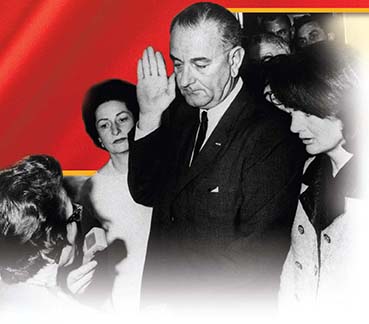SECTION 3: Johnson’s Great Society

◄ Lyndon Johnson is sworn in as President, in 1963, after Kennedy’s assassination.
WITNESS HISTORY  AUDIO
AUDIO
President Johnson’s Hopes for America
In 1965, President Lyndon B. Johnson addressed a joint session of Congress. In the speech he talked about some of his hopes for America and how he wished to be remembered by history. He explained,
“I do not want to be the President who built empires, or sought grandeur, or extended dominion. I want to be the President who educated young children … who helped to feed the hungry … who helped the poor to find their own way….”
—President Johnson, speech before Congress, March 15, 1965
Objectives
- Evaluate Johnson’s policies up to his victory in the 1964 presidential election.
- Analyze Johnson’s goals and actions as seen in his Great Society programs.
- Assess the achievements of the Great Society.
Terms and People
- Lyndon B. Johnson
- Civil Rights Act
- War on Poverty
- Economic Opportunity Act
- Great Society
- Medicare
- Medicaid
- Immigration and Nationality Act of 1965
- Warren Court
NoteTaking
Reading Skill: Identify Main Ideas Identify details about the Great Society programs.
| Education | Healthcare | Immigration | Poverty |
|
|
|
|
|
Why It Matters Lyndon B. Johnson, who became President after Kennedy’s assassination, shared the same goals as his predecessor. These goals shaped the purpose of Johnson’s Great Society program. A seasoned politician, Johnson successfully pushed through significant domestic legislation that he hoped would become the first step to achieving the quality of life he thought all Americans should enjoy. Section Focus Question: How did Johnson’s Great Society programs change life for most Americans?
Johnson’s Rise to Leadership
Born in Stonewall, Texas, Lyndon B. Johnson was raised in the Hill Country town of Johnson City. He attended Southwest Texas State College and then taught for several years in Cotulla, Texas. There, at a tiny segregated school for Mexican Americans, he confronted firsthand the challenges faced by poverty-stricken minority students, and the lessons he learned remained with him for the rest of his life.
A Determined Texan
After teaching for several years, Johnson entered politics—first as a Texas congressman’s secretary and then as the head of the Texas National Youth Administration.
In 1937, Johnson was elected to Congress, and during the next several decades he became the most powerful person on Capitol Hill. Elected to the Senate in 1948, Johnson proved himself a master of party politics and rose to the position of Senate majority




